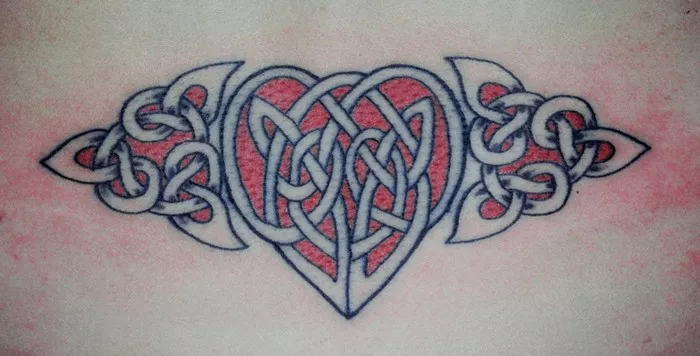In the realm of body art, tattoos serve as powerful symbols, often conveying personal stories, cultural heritage, or spiritual beliefs. Among the myriad of tattoo designs, the Celtic heart tattoo stands out as a captivating emblem, rich in history and symbolism. This article delves into the profound meaning behind the Celtic heart tattoo, exploring its origins, cultural significance, and contemporary interpretations.
Exploring the Roots: Origins of Celtic Symbolism
To truly grasp the significance of the Celtic heart tattoo, one must first delve into the roots of Celtic symbolism. The Celts, an ancient Indo-European people, inhabited vast regions of Europe, including Ireland, Scotland, Wales, and parts of France and Spain. Renowned for their intricate artwork, mythology, and spiritual beliefs, the Celts left behind a profound legacy that continues to inspire and captivate people worldwide.
Central to Celtic art and symbolism are intricate patterns known as knots, spirals, and interlaced designs. These motifs, characterized by their seamless, interconnected nature, symbolize the eternal cycle of life, death, and rebirth—the interconnectedness of all things in the natural world. Among these symbols, the heart holds a special place, representing love, unity, and the essence of the human spirit.
Deciphering Symbolism: The Celtic Heart as a Tattoo Design
When translated into the realm of tattoos, the Celtic heart takes on a deeper layer of meaning, merging ancient symbolism with personal expression. At its core, the Celtic heart tattoo symbolizes love, affection, and emotional connection. However, its intricately woven patterns add layers of complexity and nuance to its symbolism.
One of the most prominent features of the Celtic heart tattoo is its interlaced design, often depicted as a knotwork heart. This design, characterized by its continuous, looping patterns, symbolizes eternal love and the unbreakable bond between individuals. The intertwining lines represent the interconnectedness of souls, weaving together past, present, and future in a timeless embrace.
Additionally, the Celtic heart may incorporate other elements such as spirals, triskeles, or animals, each adding their own symbolic significance. For example, the triskele—a triple spiral motif—is often associated with the cycles of life, death, and rebirth, echoing the themes of continuity and transformation found in Celtic philosophy.
Unraveling Cultural Significance: Celtic Heart Tattoos in History
To fully appreciate the meaning behind Celtic heart tattoos, it is essential to understand their cultural significance within Celtic history and mythology. In ancient Celtic society, love held a sacred place, revered for its transformative power and spiritual significance. The Celts celebrated love in various forms, from romantic unions to familial bonds and friendships.
In Celtic mythology, tales of love and devotion abound, with legendary figures such as Tristan and Isolde, and Lancelot and Guinevere immortalized in stories and songs. These tales speak to the enduring power of love, capable of overcoming obstacles and transcending the boundaries of time and space.
Furthermore, the heart itself held symbolic importance in Celtic culture, representing not only love but also courage, strength, and vitality. The Celts believed that the heart was the seat of the soul, the source of one’s innermost desires and passions. Thus, the image of the heart became synonymous with the essence of human emotion and spirit.
See Also: 10 Top Celtic Warrior Sleeve Tattoo Designs in 2024
Interpreting Modern Meanings: Contemporary Perspectives on Celtic Heart Tattoos
In contemporary society, Celtic heart tattoos continue to resonate with individuals seeking to express their love, heritage, or spiritual beliefs through body art. While the core symbolism remains unchanged—love, unity, and eternal connection—modern interpretations offer a diverse array of meanings and motifs.
For some, the Celtic heart tattoo serves as a tribute to their Celtic heritage, a way of honoring their ancestors and preserving ancient traditions. Others may choose the tattoo as a symbol of personal love and commitment, a permanent reminder of cherished relationships and meaningful connections.
Moreover, the versatility of Celtic design allows for endless variations and interpretations, catering to individual tastes and preferences. Whether adorned with traditional knotwork, modern embellishments, or personal touches, each Celtic heart tattoo is as unique as the individual who wears it.
Conclusion
In conclusion, the Celtic heart tattoo stands as a timeless symbol of love, unity, and interconnectedness, deeply rooted in Celtic history and mythology. Through its intricate design and profound symbolism, it offers individuals a meaningful way to express their emotions, honor their heritage, and celebrate the enduring power of love.
As we continue to navigate the complexities of the modern world, the Celtic heart tattoo serves as a poignant reminder of the timeless truths that bind us together—the eternal cycle of life, the unbreakable bonds of love, and the interconnectedness of all things in the universe. So, whether adorned as a declaration of love, a tribute to Celtic heritage, or simply as a beautiful work of art, the Celtic heart tattoo remains a cherished emblem, resonating with the hearts and souls of all who behold it.

